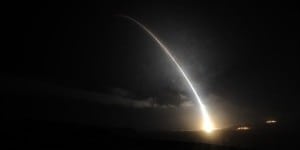
The United States is months ahead of schedule in meetings its obligations to cap the U.S. nuclear arsenal under the bilateral New Strategic Arms Reduction Treaty (START) with Russia, according to a top Air Force official.
Gen. Robin Rand, commander of Air Force Global Strike Command, said Wednesday at a Senate Armed Services strategic forces subcommittee hearing that the United States remains in compliance with New START limits, and that as of early this month “we are three months ahead” of the deadline for compliance.
The agreement requires each country by next February to limit its nuclear arsenal to 700 deployed ICBMs, submarine-launched ballistic missiles, and heavy bombers; 1,550 fielded strategic warheads; and 800 deployed and nondeployed long-range launchers.
While the U.S. and Russian nuclear arsenals have fluctuated as the two countries work to meet the terms of the deal, both sides are assessed to be in compliance.
Vice Adm. Terry Benedict, director of the Navy’s Strategic Systems Programs, said Wednesday the service has completed the work necessary for treaty compliance on 13 of 14 ballistic missile submarines and will complete an overhaul of the remaining boat next month.
Four ballistic missile launch tubes on all 14 Ohio-class nuclear submarines are being deactivated so that each vessel will carry 20 missiles instead of 24 to comply with New START numbers for both warheads and operational launchers.
The U.S. baseline plan for compliance also includes retaining up to 420 deployed ICBMs and 60 nuclear-capable bombers. The Air Force is converting 30 operational and 12 nonoperational B-52 bombers from a nuclear to conventional-only configuration to meet treaty limits.
New START is set to expire in 2021, which means the new administration must decide whether to exercise a five-year extension as allowed under the agreement, negotiate a new follow-on treaty, or abandon it altogether.
Robert Soofer, deputy assistant secretary of defense for nuclear and missile defense policy, said during the hearing that the Trump administration’s Nuclear Posture Review would consider the implications for New START of nonstrategic nuclear weapons. The review is expected to be completed this year.
“It’s not so much what’s in the treaty but what’s not in the treaty that may present the problem,” he said. The accord does not cover tactical nuclear weapons, which leaves a disparity between the couple hundred of short-range systems deployed by the United States and the thousands fielded by Russia.
This point has in part led critics of New START to argue that asymmetries in the two countries’ arsenals have caused the U.S. to make deeper cuts than has Russia.